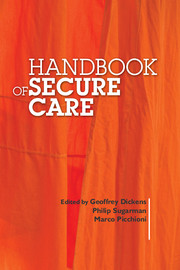Book contents
- Frontmatter
- Contents
- List of tables, boxes and figures
- List of contributors
- Preface
- 1 The evolution of secure and forensic mental healthcare
- 2 Mental disorder and offending
- 3 Clinical risk assessment in secure care
- 4 Risk management in secure care
- 5 Recovery in secure environments
- 6 Personality disorder
- 7 Women's mental health, aggression and offending
- 8 Offenders with intellectual disability in secure services and the criminal justice system
- 9 Secure mental healthcare for young people
- 10 Secure care for people with autism spectrum disorder
- 11 Acquired brain injury, trauma and aggression
- 12 Managing aggression and violence in older people
- 13 Firesetting in secure settings: theory, treatment and management
- 14 Specialist psychological treatment programmes in secure mental healthcare
- 15 Nursing in secure mental healthcare settings
- 16 Prescribing for specialist populations
- 17 Human rights in secure psychiatric care
- 18 Quality assurance and clinical audit in secure psychiatric care
- 19 Psychological support following violent assault and trauma: what works for staff in secure settings?
- Index
6 - Personality disorder
Published online by Cambridge University Press: 02 January 2018
- Frontmatter
- Contents
- List of tables, boxes and figures
- List of contributors
- Preface
- 1 The evolution of secure and forensic mental healthcare
- 2 Mental disorder and offending
- 3 Clinical risk assessment in secure care
- 4 Risk management in secure care
- 5 Recovery in secure environments
- 6 Personality disorder
- 7 Women's mental health, aggression and offending
- 8 Offenders with intellectual disability in secure services and the criminal justice system
- 9 Secure mental healthcare for young people
- 10 Secure care for people with autism spectrum disorder
- 11 Acquired brain injury, trauma and aggression
- 12 Managing aggression and violence in older people
- 13 Firesetting in secure settings: theory, treatment and management
- 14 Specialist psychological treatment programmes in secure mental healthcare
- 15 Nursing in secure mental healthcare settings
- 16 Prescribing for specialist populations
- 17 Human rights in secure psychiatric care
- 18 Quality assurance and clinical audit in secure psychiatric care
- 19 Psychological support following violent assault and trauma: what works for staff in secure settings?
- Index
Summary
Introduction
In this chapter we introduce and explore the concept, nature and classification of personality disorder. We then briefly explore theories of aetiology and the controversial issues raised by this, and then turn our attention to the practice of clinical and risk assessment with people with personality disorder. Finally, we provide an account of the theory and practice of treatment.
Personality disorder is a common and often disabling collection of conditions. Studies have estimated community prevalence to be between 4 and 11% of the UK population (Moran, 2002; Coid et al, 2006), but in forensic settings like prisons those figures are much higher. The prevalence was estimated to be 78% for male remand, 64% for male sentenced and 50% for female prisoners (Singleton et al, 1998). Personality disorder is often found in association with other psychiatric conditions (Tyrer et al, 1997), where it is generally accepted to complicate recovery (Stevenson et al, 2011).
Modern psychiatry exists in a neurophysiological model of health and an expanding pathological model of illness; effective treatments exist for conditions such as psychosis and affective disorders, such that there is also a pragmatic paradigm underpinning the medical model. With personality disorder, one cannot yet make these pragmatic arguments owing to the absence of a coherent pathological model or empirically validated treatment regimes.
The conceptual difficulties with personality disorder begin with the definition. There is broad agreement about what personality is, in terms of characteristic and long-standing behaviours and attitudes that remain pretty fixed, starting from adolescence or even before. Adding the concept of disorder to this invokes notions of the behaviours being maladaptive and causing the self or others to suffer – but this is more a matter of degree rather than type, and of subjective judgement. We will explore definitions, assessment, aetiology and treatment issues – notwithstanding that this approach assumes a medical model approach which belies the controversies that surround the issue.
Nature and classification
The current Diagnostic and Statistical Manual, Fifth Edition (DSM-5) (American Psychiatric Association, 2013) defines personality disorders as ‘enduring patterns of cognition, affectivity, interpersonal behaviour and impulse control, which are culturally deviant, pervasive and inflexible, and lead to distress or social impairment’. The important issues for diagnosis are its enduring pattern, starting at least from adolescence, its pervasive nature, affecting different areas of the person's life, and causing distress or social impairment.
- Type
- Chapter
- Information
- Handbook of Secure Care , pp. 84 - 98Publisher: Royal College of PsychiatristsPrint publication year: 2015



